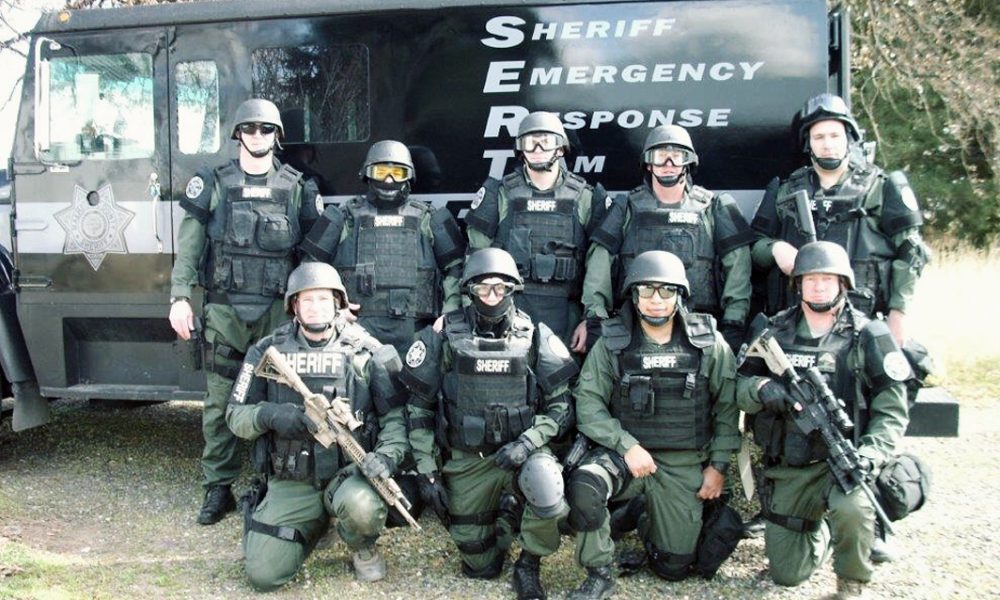 Members of the Malheur County Sheriff’s Office emergency response team train with other local police agencies to respond to a mass shooting event. (Photo courtesy of the Malheur County Sheriff’s Office)
Members of the Malheur County Sheriff’s Office emergency response team train with other local police agencies to respond to a mass shooting event. (Photo courtesy of the Malheur County Sheriff’s Office)
VALE – The televised images from the mass shooting in El Paso, Texas, showed a flood of police officers responding, and that’s what Malheur County police agencies train to do if such an event ever unfolds locally.
Law enforcement agencies in Malheur County have engaged in active shooter training as part of their multifaceted efforts to prepare themselves for the grim threat of gun violence.
Eriks Gabliks, director of the state Department of Public Safety Standards and Training, the agency that trains public safety police officers and staff, said that the department partners with law enforcement agencies across the state.
“We have a very robust training system where we take training out across the state to do active shooter training exercises,” Gabliks said.
[ KEEP YOUR LOCAL NEWS STRONG – SUBSCRIBE ]
“Columbine was a significant game changer,” Gabliks said in reference to the 1999 Columbine High School massacre when 13 people lost their lives.
“Officers responded but waited until the SWAT team was on location, which we know now is too late,” he said.
Nyssa Police Chief Ray Rau, Ontario Police Chief Steve Romero and Malheur County Sheriff Brian Wolfe, agreed that things have changed.
The Nyssa Police Department, Rau said, hosted the most recent active shooter trainings, which took place in during spring break in March using Nyssa Middle School.
Local police engaged in two days of such training.
The three agencies were joined by officers from the Baker City Police Department and Oregon State Police, Gabliks said.
Wolfe said that his department trains usually twice a year, often times at schools, but also at other venues.
“Any place that there would be multiple people around would be a good place to train,” Wolfe said. “We’ve actually had those discussions that we need to expand our training.”
Romero, who took the Ontario job after a long career in Los Angeles, said, “Active shooter training is something that has to be ongoing, scalable and ever changing.”
It is difficult to prepare for an active shooter given that each situation is dynamic and different, and also given that they can happen almost anywhere, including a “freaking Walmart,” Romero added. Gabliks said that while people focus on school shootings, it has become apparent, especially in light of El Paso and Dayton, that mass shootings can happen anywhere.
Three years ago, Nyssa police worked with Department of Public Safety Standards and Training to implement medical and fire response training as an element of active shooter training at the Nyssa Elementary School, training that is now going on state wide, Rau wrote in an email.
Rau said that when it comes to training first responders, “it’s important for them to know the layout of the building.”
Wolfe agreed that it was important to be “familiar with the different buildings” as well as “with the design and the layout of the venue.”
Rau said he and Romero have discussed increasing collaboration between law enforcement agencies in an effort to beef up training and intelligence sharing in an effort to be better equipped to handle an active shooter with precision and force.
Romero, who began his career with the Los Angeles Police Department, described this collaborative effort as a Treasure Valley training cadre that would span agencies in Oregon and Idaho.
The Department of Public Safety Standards and Training works closely with its partners on the federal and local levels, Gabliks said, and whenever there is an incident that piques national attention, law enforcement agencies adapt accordingly.
Gabliks said, “I would say that any time we have an active shooting incident anywhere…we look at our training and make sure we are meeting our needs and if we need to recalibrate, we will do that.”
The agency monitors events closely, and spends time reviewing what are called “after action reports” distributed by the FBI or Secret Service that contain analyses of specific events, Gabliks said.
“We are always looking for lessons learned, and they provide us with information that is very useful,” he added.
“We utilize any updates or any information that has been gathered through intel…as it relates to responding to an active shooter,” Ontario Police Lt. Jason Cooper added.
For Romero, collaboration is important given the region’s semi-rural topography, and distance from the west side of the state, where most opportunities and training resources exist.
“Eastern Oregon seems to be, in my opinion, forgotten a little bit,” Romero said. “The same level of concern is not placed on eastern Oregon.”
A solution, Romero said, is to have officers take advantage of opportunities to train in California.
“For specific training for local law enforcement, subject experts exist all across the country, and there are certain trainings that you just certainly have to get,” Romero said.
Romero added that if that essential training is not available in eastern Oregon, he will send officers wherever they need to go to get the training they need.
Eastern Oregon police officers will train in California, Romero said.
Wolfe’s message to the public about how to react in an active shooter situation is that “if you are willing to be proficient, I recommend concealed weapons. But with that comes some responsibility.”
Wolfe added that a gun should be used as a last resort, and with common sense.
“The public needs to take an active approach in 2019 to take the time to learn about the concepts of situational awareness and being conscious of your environment at all times,” Romero said. “Sadly enough that’s the world we live in. You can ignore it or you can be a realist. It’s the world we live in unfortunately.”
Cooper encouraged people to report suspicious activity to law enforcement.
“That information may be critical in stopping an event from taking place,” Cooper added.
News tip? Contact reporter Joe Siess: [email protected] or 541-473-3377.
For the latest news, follow the Enterprise on Facebook and Twitter.
SUBSCRIBE TO HELP PRODUCE VITAL REPORTING — For $5 a month, you get breaking news alerts, emailed newsletters and around-the-clock access to our stories. We depend on subscribers to pay for in-depth, accurate news produced by a professional and highly trained staff. Help us grow and get better with your subscription. Sign up HERE.




